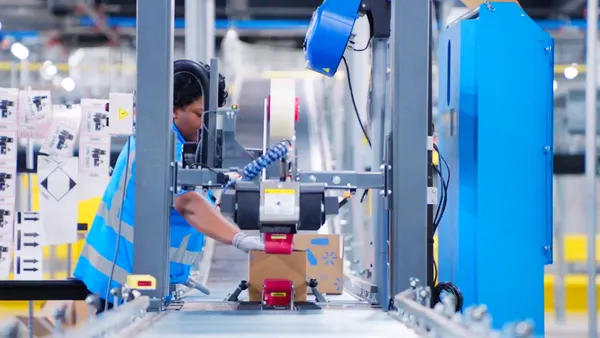This is Patent Pending. Supply chain-related patent applications are published every day and this is where we'll talk about the ones that could have the biggest impact on the supply chain and the ones that challenge the norm. We want to give you an idea of where supply chains are heading and what the industry is thinking. Read the previous issue here.
Hit the target on store-based fulfillment

Target has made store-based fulfillment a central component of its omnichannel supply chain. The retailer fulfills 80% of its digital sales volume from Target brick-and-mortor locations, CEO Brian Cornell said earlier this year. And in a patent application published last month, the company sketched out its idea for a store fulfillment manager (SFM) that would help coordinate the fulfillment process.
The SFM would first receive order information from an order management system (OMS). API connections to the existing store-based fulfillment system would then allow the SFM to publish updates on orders back into the OMS, the patent explains.
The SFM is meant to deal with some of the details that separate store-fulfillment from warehouse-based fulfillment. "For example," the patent reads, "traditional warehouse based fulfillment of orders does not have to compete with other demands on the supply of goods within the warehouse — the goods that are in the warehouse are available for shipping." In a store customers are also buying goods, constantly changing the inventory levels.
To account for the unique setting, the SFM would use demand projections when deciding from which store to fulfill an order, to ensure its inventory levels are adequate for current demand and future demand.
Read up:
-
Target's tech for store-based fulfillment operations is ready to scale
-
For a fast supply chain, Target is betting on in-store fulfillment
-
Target's same-day fulfillment growing at twice the rate of last year
Can you hear your inventory?

Knowing how much inventory is in a retail store is a tricky problem. When customers put an item in their cart, they can then walk around the store before reaching check out, where the inventory is accounted for. Real-time inventory is important in an omnichannel environment where a retailer is trying to decide if a store can fulfill an online order. This column has mentioned before the retailer's idea for using curved shelving that flattens as inventory is placed on it. In a patent application published last month Walmart has another possible solution: just listen.
Walmart's idea is to measure inventory levels using microphones to detect changes in echos in the store. Microphones would pick up sound throughout a store or storage facility and send the information to a computing system that will calculate an inventory estimate "based on the intensity, amplitude and/or frequency of the sound," the patent reads.
We'll let you know if Walmart ever incorporates taste and scent into inventory management.
Read up:
-
Inventory, network optimization among most widely adopted supply chain technologies
-
How a new framework can improve an existing inventory management system
Automated depalletizing

Palletizing inventory is a common, standard way to move inventory around. But depalletizing is a labor-intensive process. In a patent application filed this month, inVia Robotics argued that automating the process can cut down on mistakes and save on labor costs.
To automate depalletizing, inVia envisions two potential methods: one with a single robot that can retrieve the inventory from the pallet itself and then move it, and another where two robots work together with one removing the item from the pallet and another moving the inventory.
Automating this process can be difficult because the stack of inventory on top of a pallet can take on a multitude of configurations. Automation doesn't like nonstandard processes.

In the case where there is one robot working alone, it would use a sensor to scan the entire pallet and then employ a scissor-lift mechanism to raise itself until it doesn't sense anything on the stack. It would then send data back to a processor that would do image matching, and the robot would lower itself until its base is lined up with the bottom of the topmost item. An arm would then come forward to pull the inventory onto the robot.
inVia suggests that using another robotic arm to unload pallets onto multiple other mobile robots, though, "may improve the rate at which objects are extracted from the pallet."















